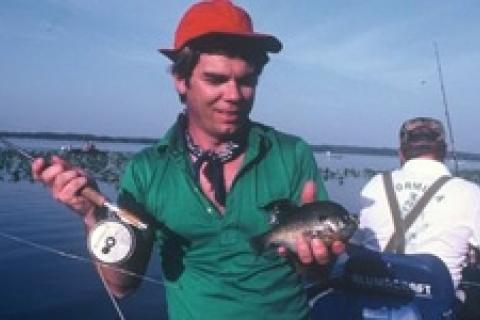
 For simply going out and having a fun day on the water without traveling a great distance or spending much money, it's hard to find a more obliging quarry than the humble bluegill.
For simply going out and having a fun day on the water without traveling a great distance or spending much money, it's hard to find a more obliging quarry than the humble bluegill.
While often thought of as a fish for novice anglers, the truth is, these colorful panfish offer many attractions for experienced fishermen as well. Bluegills and their relatives such as shellcrackers and pumpkinseeds put up a powerful struggle on refined gear. Find a lake with 3/4 to 1 pound fish and you'll enjoy some of the most memorable sport available in freshwater. Even the more typical half-pounders, though, are strong enough to create a sharp bend in a thin lightweight rod.
Besides being fun to catch, sunfish are widely available across the country, inhabiting anything from half-acre farm ponds to sprawling impoundments, narrow creeks to broad, sweeping rivers.
You don't need any expensive equipment, either. You can fish from a johnboat, canoe, float tube or simply wade or cast from shore. Bluegills are also delectable. Pan-fried, broiled or baked the flesh is firm, mild and tasty.
You can also catch them year-round. In winter they often hold in deep water over structure such as humps, creek channel edges, drop-offs, stump fields, depressions in the lake floor and points. As waters warm in the spring, the fish head for shallower water for three reasons: the water is warmer there, food is more abundant and that's where spawning takes place.
Summer is a favorite season for many panfish anglers with the quarry feeding heavily and easy to catch. When you find their favorite hangouts, landing dozens of fish is often possible during spring.
Cast to any cover you see, such as brush piles, rocks, grassy banks, points, logjams, weed beds and shoals in depths of 2-6 feet. Concentrate on backwater bays, coves and the shallow ends of ponds. In rivers, fish slow pools, side eddies and sloughs off the main current.
As waters reach spawning temperature (around 65-70 degrees), focus on likely bedding areas with sand, clay or gravel bottoms. You can sometimes see the beds, which appear as 12- to 24-inch circles fanned out on the bottom. You might also see the fish themselves hovering suspended in large schools in the thin water. Mating is often heaviest around the full or new moon from May through July.
If you can't find bluegills schooling on beds or if the spawn is finished, start looking in deeper water. Work 8- to 18-foot depths near structure such as dropoffs, ledges, humps and deep points. This is where most panfish will hang out during the warm months. Fish the same spots that produced in winter, but don't ignore the shallows at dawn and dusk, when the fish often move in to thin water to forage on insects and crustaceans near weeds, brush piles and grassy banks.
In the fall, as waters cool, bluegills spend more and more time in those shallows throughout the day, instead of just at dawn and dusk. Then, as water temperatures drop into the 50's and 40's, they'll begin gradually dropping back to deeper cover again as winter marches in. Try vertical jigging with tiny slab spoons or fishing live bait for these lethargic cold-water fish.
- 2303 views

